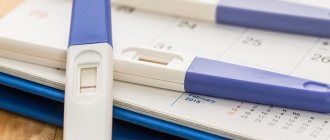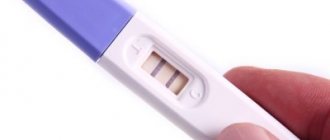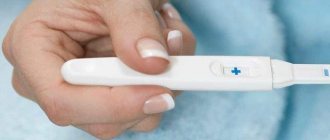A rapid pregnancy test is considered the most accurate way to determine conception. However, even such ultra-sensitive devices can fail.
A pregnancy test can be false positive for various reasons. Before you panic, you need to find out why the error occurred, as sometimes it is associated with serious health problems.
What could be the reason for an erroneous result and how to find out the reliability of the test? Let's look at this issue in more detail in this article.
What is a false positive pregnancy test?
If a girl tested before her period, the result may be erroneous. This is due to the fact that in the early stages of fetal development the amount of chorionic hormone synthesized has not reached the required concentration. Because of this, the express strip does not indicate that fertilization has occurred.
Therefore, gynecologists recommend testing on days 2–3 of the delay or immediately after it. Only then will it be possible to obtain the most reliable results.
The hCG hormone is sometimes synthesized in the female body even without fertilization. If a woman has thromboplastic neoplasms in her body, a pregnancy test may show a positive result. This is due to the fact that such cells synthesize the same hormone as the placenta, so when performing a home diagnosis, the test will show a second strip.
Faintly developed or blurred stripes are also considered a false positive result. If the first test gives this result, it is best to repeat the diagnosis in a couple of days or immediately contact the antenatal clinic.
A home rapid pregnancy test is a convenient and easy-to-use device that can quickly determine whether a girl is pregnant. Devices from popular manufacturers have high sensitivity and most often show the correct result in 95% of cases.
However, erroneous results may occur due to health conditions or other abnormalities. Why do these reliable devices make mistakes?
Negative result if pregnant
The rapid test reacts to human chorionic gonadotropin. The concentration of this hormone in the urine decreases and becomes insufficient for a positive result if the amount of urine excreted increases. This can happen if the woman has eaten any diuretic foods (such as watermelon) or taken a diuretic drug.
If a woman's cycle is disrupted, ovulation could occur later than usual. In this case, pregnancy, even if it has occurred, has not yet had time to cause the corresponding hormonal changes by the time the woman notices a delay in menstruation. If you repeat the test a week later, the result will be positive.
The concentration of human chorionic gonadotropin decreases in some pathological variants of pregnancy: threatened miscarriage, frozen or ectopic pregnancy. Such cases require immediate medical intervention.
Another possible reason for a decrease in the level of gonadotropin in the urine, leading to a test error, is impaired renal function.
When a test shows a false positive result - an overview of possible reasons
Several factors influence the performance of devices.
Let's study them.
Human factor
Incorrect diagnostic answers are obtained for the following reasons:
- During the study, the instructions for use of the device were not followed, or the container for biological fluid was dirty.
- The woman violated the storage conditions for the dough or accidentally knocked over a container of liquid on it.
- Self-hypnosis. A girl can convince herself that she is pregnant and see two ghostly lines.
- The woman conducted the study during ovulation.
- If the girl is still breastfeeding, the test will show a positive result, since little time has passed since the previous birth.
- Psychological state of a person. If a girl is very worried or, conversely, has experienced a lot of positive emotions, a strong surge of hormones occurs in the body, which will lead to false results.
Health reasons
Quite often, when the second line appears, a woman thinks that the test was simply wrong or that she did it incorrectly. However, this is not always the case. A positive answer is not always displayed for trivial reasons. Sometimes the reason for this is serious health problems.
Possible reasons for erroneous analysis:
- pelvic diseases;
- endometritis;
- ectopic pregnancy;
- hepatitis;
- HIV;
- syphilis;
- ovarian cyst;
- corpus luteum cyst;
- hormonal imbalances;
- the onset of early menopause;
- development of cancer cells;
- uterine fibroids;
- miscarriage.
Health is not something to joke about, because if treatment is not started on time, it will lead to serious consequences. If a girl shows signs of ill health (pain in the lower abdomen, dizziness, nausea, fever, spotting), and the test gives two lines, then you need to immediately contact a gynecologist and undergo a full medical diagnosis.
If any abnormalities are detected, immediate treatment must be started. Don’t be afraid of going to the doctor; an unscheduled examination by a gynecologist will help you find out whether the woman is healthy and whether the long-awaited fertilization has occurred.
Other reasons
An erroneous positive test can also occur if the girl was taking medications containing hCG or taking birth control pills before diagnosis. In this case, to avoid errors in the study, it should be carried out 14–15 days after the end of the course.
And also before using the device you need to carefully look at the expiration date. If it is expired, then the likelihood of a true result is very small. This is due to the fact that after the expiration date, the reagent in the test dries out and loses its properties. Therefore, the test results will be inaccurate. It is best to go to the pharmacy and buy another pregnancy test.
What to do if a test fails
The action to take if a test fails depends on the reason for the false result. As mentioned above, you should definitely contact your gynecologist to understand why the testing was false. If the cause is a disease of the female genitourinary system, the doctor will prescribe treatment.
When the result of the procedure was positive, but the ultrasound sensor did not detect anything, it is worth taking a blood test for hCG. If the gynecologist does not refer you to it, contact a paid clinic to be sure of the result.
An ectopic pregnancy is the most dangerous reason for a test to fail. In most cases, it is accompanied by pain in the lower abdomen and bleeding, but sometimes there are no symptoms.
In an ectopic pregnancy, the embryo cannot develop and dies. The body rejects it and a miscarriage occurs. A much more favorable outcome for a woman will be if the pathology is diagnosed in time by a doctor and an abortion is performed, since after a miscarriage there can be disastrous consequences, including loss of reproductive function.
How to handle a false positive test result
Modern testers have increased sensitivity of 90–95%. The electronic test from the Clearblue company has a hypersensitivity of 99%. Therefore, if you carry out diagnostics in compliance with all the rules, the results will be correct in 99% of cases.
However, there are times when the express strip shows two lines, but there is no pregnancy. There is no need to panic right away. The accuracy of the results cannot be judged from just one test.
First of all, you need to re-test after 2 days. If it also shows two stripes, you need to visit a gynecologist’s office and undergo a medical examination.
Don't forget about the color of the second stripe. If after testing the second stripe appears pale pink or blue, then there is most likely no pregnancy. This phenomenon may be due to non-compliance with the instructions or a malfunction of the tester.
There are also many other factors to consider when conducting a home study. In any case, if two lines appear on the express test, you need to contact the antenatal clinic and make sure that your testing is correct.
How to tell if a test is wrong
It is impossible to find out on your own whether a result is false or reliable. In this regard, doctors recommend testing twice. The second procedure is best carried out two days after the first. If both tests were negative, but menstruation still does not occur, you should definitely consult a doctor.
If the result is positive, you should also visit a doctor. Only a specialist will reliably find out whether the test was wrong.
In both the first and second cases, the patient undergoes an ultrasound, with the help of which the result is confirmed or refuted and the cause of the error is clarified.
How to act so as not to make mistakes
Any device makes mistakes, even electronic ones. To avoid mistakes, you must carefully study the expiration date of the device, storage method and instructions for use. According to experts, it is best to buy devices at a pharmacy.
When choosing a device, you need to pay attention to the manufacturer. The most popular and in demand devices are often the most accurate. The company is responsible for quality assurance, so defective batches are rare.
Pay attention to the price of the device. If its cost is minimal, then it may be made from low-quality and inexpensive materials, which negatively affects accuracy. Follow the instructions and recommendations, then the likelihood of errors will be minimal.
A reproductive specialist will tell you how to avoid mistakes when determining pregnancy.
What to do to make the result as accurate as possible
For testing to provide accurate data, you need to:
- Don't rush into using the test strip. It cannot be too late in this matter. If a girl did the testing before the start of the delay, the likelihood of an error is very high. The optimal time to obtain accurate information is the first week from the expected start date of menstruation. It often happens that menstruation comes 3-4 days after the expected delay, which is caused by stress or hormonal changes (for example, a failure in the production of luteinizing hormone lh, which is responsible for the stability of the menstrual cycle).
- Ensure the suitability of the test system - check the expiration date and integrity of the packaging.
- Follow the instructions for use of the product.
- Try not to worry. The absence of menstruation on time is an absolute cause for concern, but you should not buy a lot of tests, do them every hour and panic, either if the girl really wants to be pregnant, or if she is not at all ready to become a mother in the near future.
An obstetrician-gynecologist tells more about when you need to use a test system to get an accurate result:
How to avoid mistakes
Can a pregnancy test be wrong if the result is positive? Some analyzes carried out using a rapid test may be erroneous due to “technical” reasons. The test may be of poor quality or expired.
When buying a test at a pharmacy, check its expiration date, the integrity of the packaging, and ask for a certificate for this product.
Only a hermetically sealed device may be used for analysis. Only before direct use should you print the package.
Incorrect storage conditions can also lead to erroneous results. Therefore, the device should only be purchased at a pharmacy to ensure that it is stored under the required conditions.
The girl herself is capable of misleading herself if she does not follow the instructions for the user. Even stale urine can change the result.
Varieties
Today there are few varieties of home tests, each with its own characteristics, disadvantages and advantages.
- Test strips (for example, Evitest). This is the most accessible, cheapest option, which, according to statistics, is often wrong. The strip is impregnated with a special composition. It is immersed in urine to a certain level, held for about 30 seconds and placed on a dry surface. Results can be determined in 3-5 minutes. A large number of erroneous results when determining conception are explained by improper use (kept in urine for a long time, dropped above or below the mark, etc.). That is why, when using, in order to minimize the likelihood of a pregnancy test error, it is necessary to strictly follow the steps specified in the instructions.
- Jet. Such test devices are considered the most sensitive, and therefore the most reliable. A special feature is that there is no need to dip the strip into the container; you just need to place it under the stream when urinating. The results can be read in just a couple of minutes.
- Tablets. They are considered a second generation invention, so they are more expensive than test strips, but also more reliable. The device looks like a cassette with small windows. You need to drop urine from a pipette into one window, and read the indicators in the other.
- The most convenient is a reservoir system with a special container for collecting urine. This container already has a built-in test strip that absorbs the required volume of urine. The result appears after five minutes on the strip built into the side.
These are the most famous home diagnostic tests today. Do pregnancy tests lie? Of course, any rapid test can show false information. Moreover, most often this happens due to incorrect application and non-compliance with the rules in the instructions.
Why does a false negative result occur?
Whether a pregnancy test can be wrong, despite the fact that all the signs accompanying pregnancy are present, is of concern especially in anticipation of the long-awaited conception.
The test may give an incorrect result if the test is not timely, it was carried out on the first day, when menstruation did not start, and a test with low sensitivity was used. This result is called a false negative and is much more common than a false positive.
An erroneously negative pregnancy test may be due to one of the following reasons:
- whether the woman drank a lot of water or a diuretic before the test;
- diseases of the cardiovascular system or kidneys can affect the release of human chorionic gonadotropin, since its insufficient amount for the test gives incorrect readings;
- a decrease in hCG to a minimum, insufficient to be determined by the test, also occurs when there is a threat of miscarriage;
- frozen pregnancy (fetal death, most often occurring in the first months);
- ectopic pregnancy.








